
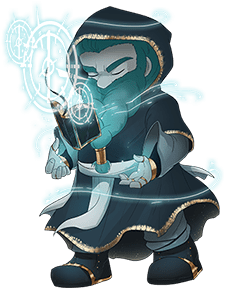
The following Monster Hunter class for Grim Hollow and 5e is playtest material. This article covers levels 1-3, levels 4-8 can be found here, with further levels coming in future articles. The Monster Hunter includes writing and mechanics contributed by Skawabii.
“Being a monster hunter was not something I was born into. My father told me to go out and get a trade. He wanted me to apprentice under the finest professional in my field. He didn’t want me to live a poor life growing crop to have it stolen by brigands or richer men. But I don’t think this is what he had in mind…”
– Jürgen of the Black Arrow
A half-orc trudges into town alone. A trail is stained into the soil behind him from the day’s gritty work. He makes his way with an exhausted calm, a hooked scythe in one hand and a beast’s severed head in the other. Gathering villagers look to the head still dripping with gore, then to the half-orc, his gaze emotionless and his expectations clear. Townsfolk scamper to scrape together their promised reward to the monster killer, as they understand this is someone who handles bad faith poorly.
When city folk are laid to rest within the mausoleum, they most often stay there. On this day, however, the dead lazily roam the halls searching for a way out. A skeleton sheathed in tattered skin shatters with a thunderous boom upon shambling over an explosive trap. The sound attracts more rasping zombies, the halfling who set the trap taking careful aim with her crossbow as they wander into her line of fire.
A master and apprentice recite an old chant passed down from their guild as a crowd of royal servants look on warily. The servants’ lord had long feared rumors of a monster living within the castle walls. In their desperation, the lord chose to rely on the chanting pair. Their trust was not in vain, as when the arcanists’ scatter a fistful of shining dust into the royal chamber, one of the maids’ shrieks, twists, and contorts into her true form.
Monster Hunters, as their title suggests, spend their lives hunting and killing all manner of abhorrent creatures. But the stories and legends about these travelers tend to be exaggerated, often suggesting that they are noble knights-errant in search of townships to rescue from local fiends. Other tales tell of sinister loners that cause more problems than they solve, cavorting with the creatures they claim to kill and leaving behind hellish offspring. The truth is far more mundane than common folk are willing to take interest in, as most monster hunters are simply professionals looking for work.
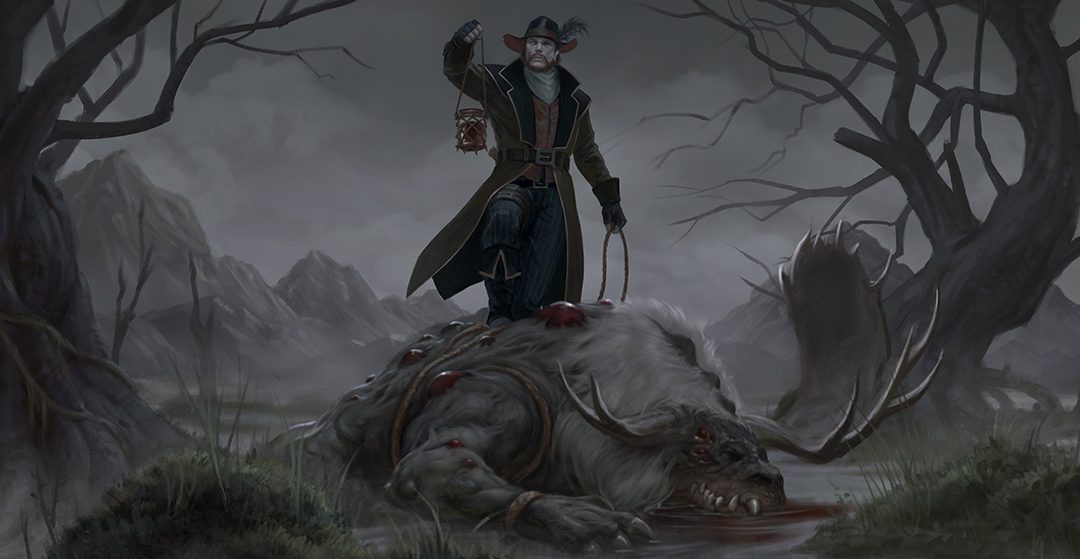
Artist: Andreia Ugrai
Consummate Professionals
Each monster hunter specializes in identifying, seeking, and killing different types of creatures. Therefore, each monster hunter also specializes in different methods for doing so. While some hunters don heavy armor and carry shields to protect against crushing jaws and scything claws, others prefer to remain light and agile to keep distance between themselves and their quarry.
Each guild of hunters operates under their own professional code, and each hunter their own moral compass. Most guilds refuse coin for killing common folk. A hunter will likely object to being sent after other sentient creatures such a warband of Valikan half-orcs or a clan of bugbears yet to be affected by Tormach’s Rage.
Highly Trained Specialists
Monster hunters are typically trained from a young age. They may have apprenticed once old enough to read, write and bear arms, or were themselves raised by members of their own guild.
What separates a monster hunter from other mercenaries is the importance their training places upon education and knowledge. A monster hunter knows that bravado and a strong sword arm are often not enough to survive their preternatural prey. Therefore, they spend years studying alongside their physical training. Such is their learning that a monster hunter could identify a wraith from a specter or differentiate the tracks of a griffin from a manticore.
Creating a Monster Hunter
As you create your monster hunter, there are two main questions to consider.
The first is the nature of your monster hunter training and education. Were you disciplined in a guildhall where the techniques of your trade are the closely guarded secret of your tutors? Or were you mentored on the road by a hunter who took you in?
As a starting character, you’ll choose two monster types that you specialize in hunting. When you reach higher levels, you will also choose a hunting guild which represents the maturing of your knowledge and therefore could reflect the nature of your early education.
Think about why you specialize in hunting certain monster types. Are they the same types of monsters your mentor or guild specialized in? Or did your research branch into other creature types due to special interest? Did your mentor raise you as part of the carver guild, specialized in close quarters fighting against dangerous monstrosities? Or did they tutor you in creating traps and equipment from dragon bones? It also is possible your early training provided you with a broad education or that you are self-taught, only choosing to specialize in later life.
The second question to consider is your motivation for being a monster hunter. Is it purely a professional endeavor for which you expect to be well compensated? Or are you trying to make the world safer one monster at a time?
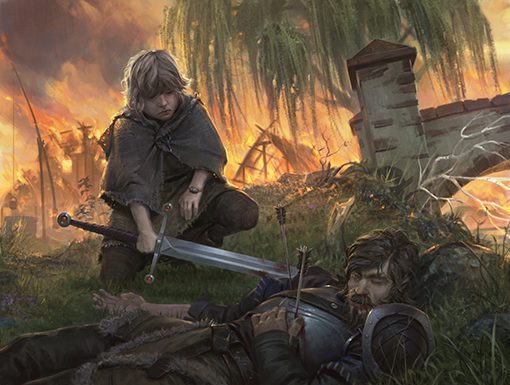
Artist: Marius Bota
Your motivations may be complex and even a source of internal conflict. Perhaps it pains you to slay such rare and misunderstood creatures, but you’ve learned no other way to provide for yourself? Or your guild code forces you to take payment for each beast killed, despite feeling like you’re taking advantage of poor villagers far too often? Perhaps you simply enjoy the challenge of the hunt and the adrenaline you get when a beast lunges?
Your motivations may tie back into the monsters you specialize in. For example, you may be seeking revenge against the types of creatures that destroyed your home or took your mentor away. There may even be beasts you refuse to hunt, or beasts you refuse to take payment for. This could include a conscientious objection to slaying sentient creatures defending their territories from human expansion. Or maybe you so detest the creatures you specialize in hunting that you will gladly seek them out and destroy them with or without compensation.
Quick Build
You can make a monster hunter quickly by following these suggestions. First, make Strength or Dexterity your highest ability score, depending on whether you want to focus on melee weapons or on archery (or finesse weapons). Your next-highest score should be Intelligence.
Second, choose a background that reflects your training and the monsters you specialize in hunting, or alternatively your background could reflect your character’s life before they fell into the monster hunting profession.
If you are using advanced backgrounds from Grim Hollow: The Campaign Guide, the Beast Hunter profession from the Outlander background is perfect for any lifelong monster hunter characters.
Class Features
As a monster hunter, you gain the following class features.
Hit Points
Hit Dice: 1d10 per monster hunter level
Hit Points at 1st Level: 10 + your Constitution modifier
Hit Points at Higher Levels: 1d10 (or 6) + your constitution modifier per monster hunter level after 1st.
Proficiencies
Armor: Light armor, medium armor, shields
Weapons: Simple weapons, martial weapons
Tools: None
Saving Throws: Strength, Dexterity
Skills: Choose two skills from Athletics, History, Investigation, Medicine, Nature, Perception, Religion, and Survival
Equipment
You start with the following equipment, in addition to the equipment granted by your background:
- (a) scale mail or (b) leather armour
- (a) a martial weapon and a shield or (b) two martial weapons
- (a) a light crossbow and 20 bolts or (b) two simple weapons
- (a) a dungeoneer’s pack or (b) an explorer’s pack
Fighting Style
You adopt a particular style of fighting as your specialty. Choose one of the following options. You can’t take a Fighting Style option more than once, even if you later get to choose again.
Archery
You gain +2 bonus to attack rolls you make with ranged weapons.
Duelling
When you are wielding a melee weapon in one hand and no other weapons, you gain a +2 bonus to damage rolls with that weapon.
Great Weapon Fighting
When you roll a 1 or 2 on a damage die for an attack you make with a melee weapon that you are wielding with two hands, you can reroll the die and must use the new roll, even if the new roll is a 1 or a 2. The weapon must have the two-handed or versatile property for you to gain this benefit.
Two-Weapon Fighting
When you engage in two-weapon fighting, you can add your ability modifier to the damage of the second attack.
Monster Grimoire
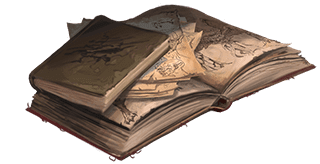
Artist: Suzanne Helmigh
Each monster hunter carries with them a grimoire of lore and research about the creatures they hunt.
Choose two types of monsters that you are specialized in hunting from the following list: aberrations, beasts, constructs, dragons, elementals, fey, fiends, giants, monstrosities, oozes, plants, undead, or humanoids (shape changers).
You add your proficiency bonus to any Intelligence and Wisdom checks you make that relate to the monsters in your grimoire. For example, an Intelligence (History) check to recall lore about a creature you’re investigating, or a Wisdom (Medicine) check to identify claw marks left on a corpse. If you are already proficient in a skill when asked to make an ability check relating to the monsters in your grimoire, you are treated as having expertise for the purposes of that ability check and double your proficiency bonus instead.
When you gain this feature, you also learn one language of your choice that is spoken by one of the monster types in your grimoire.
Other class features you gain also refer to the monsters in your grimoire.
A monster hunter’s grimoire is an object that is entirely unique to them. It may be a leather tome recovered from a dusty library with notes made in the margins, a frayed journal inherited from a previous hunter, or a precious stone with a communing spirit trapped within. If a monster hunter ever loses their grimoire, they have usually retained enough of the knowledge to not suffer any immediate disadvantages. However, they cannot further their research without one and therefore cannot take another monster hunter level at level up until a lost grimoire has been replaced. A grimoire can be recreated by spending 8 hours and 50 gp worth of materials such as pages, inks, or components to cast a ritual.
Hunter’s Instincts
At 2nd level, you gain the ability to analyze a creature and discern specific information about it. As a bonus action, choose one creature you can see within 60 feet of you, and make an Intelligence (Investigation) check where the DC equals 5 + the creature’s CR. The check is automatically successful against creatures with a CR less than 1. If you are successful, you learn one of the following pieces of information.
- The creature’s type.
- The creature’s armor class.
- Any damage resistances or immunities the creature has.
- Any damage vulnerabilities the creature has.
If you spend at least 1 minute observing or interacting with the target creature outside of combat, you can learn the first two pieces of information automatically, and the second two with a single Intelligence (Investigation) check of the same DC as described above.
If the creature is concealing any of these pieces of information with magic, such as an illusion, you do not learn that piece of information with a successful ability check but instead become aware that the information is being concealed.
Hunting Guild
At 3rd level, you choose a hunting guild that best reflects the techniques you employ in tracking and slaying monsters. Choose between the Carver Guild or the Trapper Guild, both detailed below. The guild you choose grants you features at 3rd level and again at 7th, 10th, 15th and 18th level.
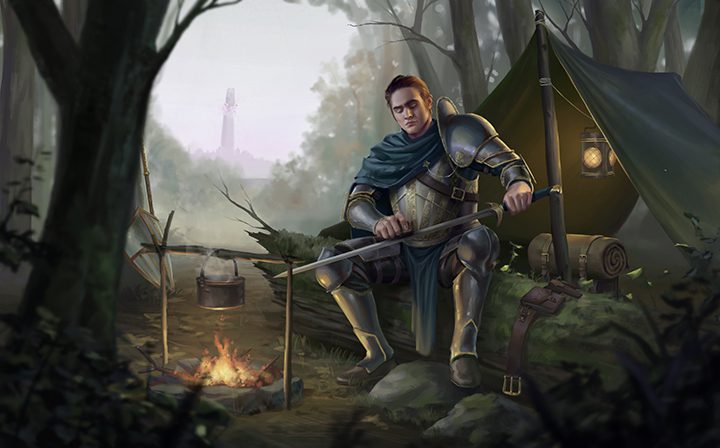
Artist: Elizabeth Peiró
Carver Guild
Since the beginning of time, monsters were fought by those who were brave enough to get close to danger and glare into its ferocious eyes. The folk that survived were those smart enough to arm themselves properly and know precisely where to strike for the quickest kill.
Carvers are the monster hunters that are typically called upon when immediate danger threatens a settlement and action is in short supply. Carvers stride unflinchingly toward death, armed with years of training and knowledge that is both researched and passed down from those before them.
Bonus Proficiency
When you choose this guild at 3rd level, you gain proficiency with heavy armor
Close Quarters
Starting at 3rd level, your resolve allows you to keep the pressure on your target while mitigating the risk to yourself. Whenever you hit a creature with a melee weapon attack you can mark them until the start of your next turn. While creatures that are marked are adjacent to you, they have disadvantage on attack rolls against you.
True Grit
Starting at 3rd level, you are immune to being frightened by creature types written about in your grimoire.
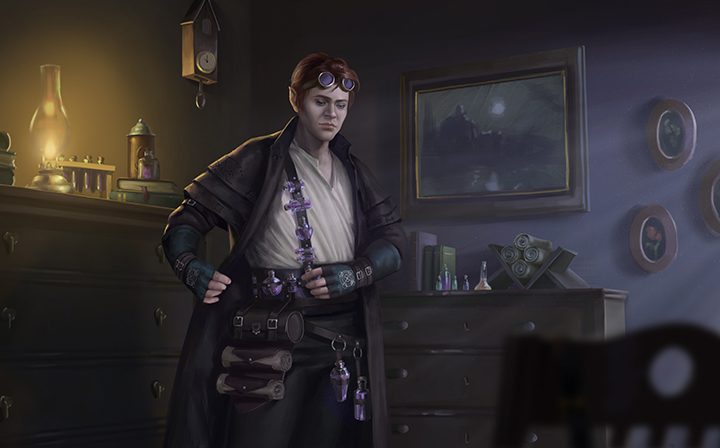
Artist: Elizabeth Peiró
Trapper Guild
Legends say that the founding members of the Trapper Guild were regular game hunters who had grown bored of the common elk and dreamed of taking down bigger game. Trappers take pride in their kills and the ingenuity exhibited when a trap works perfectly.
The legacy of the Trapper Guild is a consistent testament to the benefits of lying in wait. The element of surprise is paramount to the Trapper, whose kit can flourish before the hunter and monster even meet. Preparation is key, and the resourceful Trapper has devices to overcome even the strongest foes.
Bonus Proficiency
When you choose this guild at 3rd level, you gain proficiency in the Stealth skill.
Trapper’s Tools
Starting at 3rd level, you gain proficiency with Tinker’s tools and can use these to create gadgets and mechanisms that help you during the hunt. Whenever you finish a long rest, you can use your Tinker’s tools to craft two of the following trapper’s tools described below.
You can also spend 1 hour and 20 gold pieces worth of additional resources (such as equipment or monster salvage) to use your Tinker’s tools to craft a single trapper tool. The time spent must be uninterrupted and can be during a short rest.
Some trapper’s tools allow your target to make an ability check or saving throw to resist the tool’s effects. The saving throw DC is calculated as follows:
trapper’s tool Save DC = 8 + your proficiency bonus + your Intelligence Modifier
Elemental Ammo. The head of an arrow or bolt is tipped with poison, loaded with an acid vial, or dipped in flammable oil. You create a single piece of ammunition that can be fired from either a bow or crossbow as part of an attack action. If that piece of ammunition hits, it inflicts three times the weapon’s normal damage dice. The damage type can be either acid, fire, lightning, poison, or thunder, chosen when the ammunition is crafted.
A piece of elemental ammo breaks after use and cannot be recovered.
Push Plate. A chest guard, filled with compressed air or loaded with springs. It can be worn over clothing and armor and takes the same time to don and doff as light armor. If the wearer is hit by a melee attack, it can use its reaction to activate the push plate. If the wearer is larger than the creature who attacked it, the creature will be pushed back up to 20 feet. If the creature is the same size or larger than the wearer, the wearer will be pushed back up to 20 feet, instead.
The push plate is destroyed after a single use.
Scorpion Anchor. This weapon is intended to keep flying foes anchored to the ground or stop monsters from fleeing. The scorpion anchor can be fired from either a bow or crossbow as part of an attack action. A creature hit by the attack becomes grappled, ending the effect if it uses an action on its turn to succeed on a Dexterity (Acrobatics) or Strength (Athletics) check.
A scorpion anchor is destroyed after use and cannot be recovered.
Silver Bomb. Silver bombs are used when hunting creatures that are resilient to mortal weapons. As a bonus action on your turn, you can throw the silver bomb at a point that you can see within 60 feet, creating a 20-foot-radius sphere centred on that point. The sphere spreads around corners, and its area is lightly obscured. It lasts for 1 minute or until a wind of moderate or greater speed (at least 10 miles per hour) disperses it. While inside the sphere, any aberration, elemental, fey, fiend, humanoid, monstrosity or undead loses any resistances or immunities that it has to bludgeoning, piercing, and slashing damage.
A silver bomb is destroyed after a single use.
Terrain Cloak. A cloak composed of or disguised with local materials, allowing the wearer to conceal themselves within the environment. Terrain cloaks can be worn over light and medium armor and are donned and doffed with the speed of light armor.
The wearer of a terrain cloak is always lightly obscured. The wearer also receives advantage on stealth checks that rely on sight and can attempt to hide even if only lightly obscured by their terrain cloak.
Terrain cloaks tend not to last as the dust wears off and the dead branches break or whither. Terrain cloaks fall apart after 24 hours.
Weretrap. A strong staggering trap that is triggered when its fragile exterior is broken. You can use an action to set the trap on the ground in a space adjacent to you. Weretraps placed on the ground are invisible to other creatures unless they succeed a Wisdom (Perception) check. A creature that steps on the weretrap must succeed a Dexterity saving throw or take 3d10 bludgeoning damage and be knocked prone.

Artist: Suzanne Helmigh
The weretrap can also be used as a ranged weapon with the finesse and thrown property. It has a short range of 20 feet and a long range of 60 feet. On a successful hit, the weretrap deals 3d10 bludgeoning damage and the target is knocked prone.
The weretrap is destroyed after it is triggered or thrown, regardless of whether it was successful or not.
Predatory Awareness
Starting at 3rd level, you can’t be surprised by creature types written about in your grimoire while you are conscious.

![Grim Hollow: The Player's Guide [PDF]](https://b2358178.smushcdn.com/2358178/wp-content/uploads/2021/02/Grim-Hollow-players-Guide-PDF-600x600.jpg?lossy=1&strip=1&webp=1)
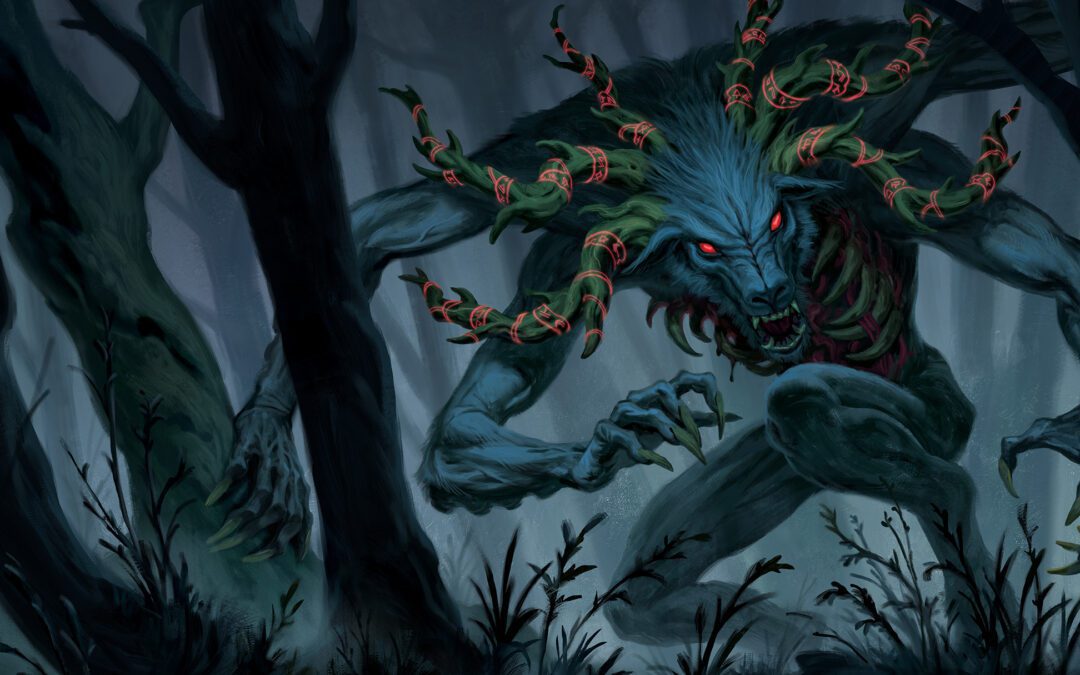
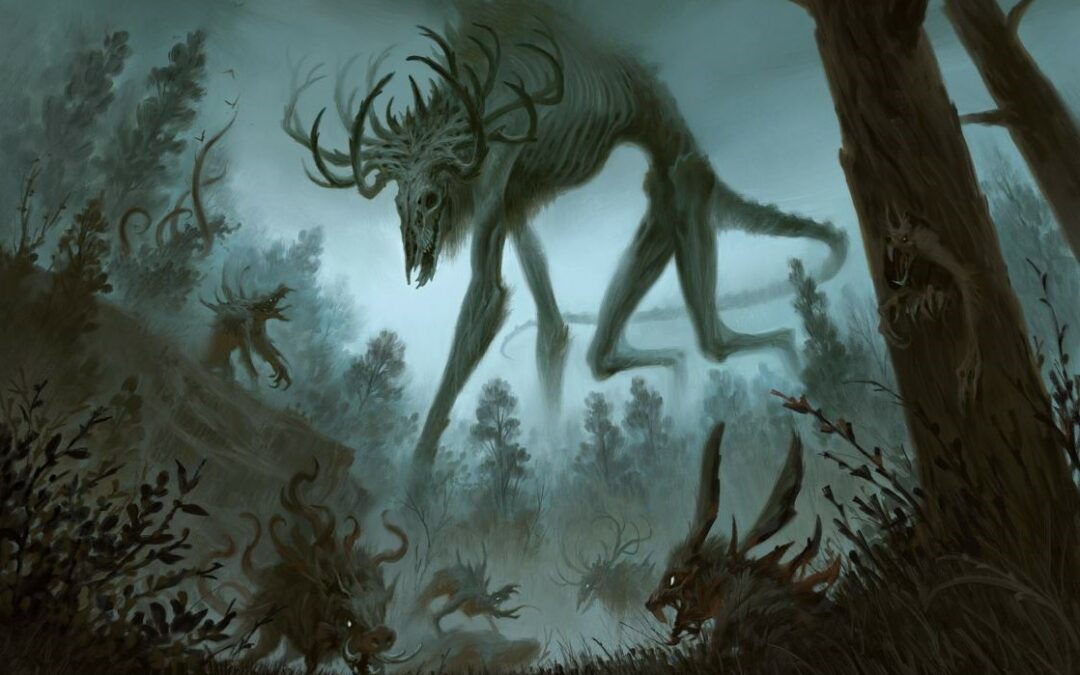
I play tested the monster hunter class and I can say both types of play styles are fun and engaging I would recommend a adding a few more guilds for both flavor and added options perhaps a monster hunter that looked into the abyss? I myself played a dex archer that would set traps and allow the barbarian to beat the monster in while I would pelt it with arrows I hope to see level 4-20 I love the potential this class has.
Is there a way to change or extend the monster types you hunt?
Yes! At 6th level, and again at 13th and 17th, you choose new monster types to add to your Grimoire (check out the other monster hunter articles to see higher level bonuses). This expands your monster hunting knowledge and bonuses to those monster types. In terms of changing monster types, that isn’t currently part of the class as your monster grimoire is a physical artifact and the bonuses it provides are strong enough that it’s designed not to be overly flexible. However, perhaps discuss with your GM about whether you can change monster types at a level up or when you next gain a Monster Grimoire improvement.
Is there a json file of this class